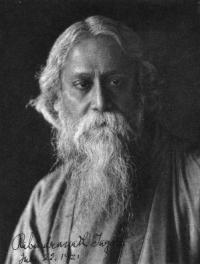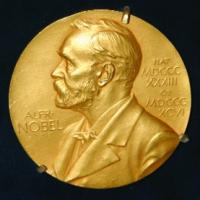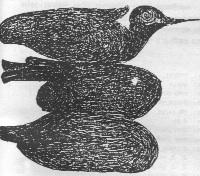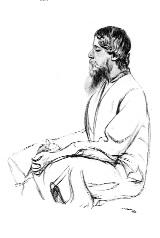Literature: Mythologising a ‘mystic’:W.B. Yeats on the poetry of Rabindranath Tagore
Published in 20th-century / Contemporary History, Features, Issue 4 (July/August 2010), Volume 18
Bengali poet Rabindranath Tagore in 1921—with his flowing beard and sweeping robe he seemed the epitome of all stereotypes oriental.
On his third visit to Britain, in 1912, Bengali poet Rabindranath Tagore met with a variety of literary figures, such as Ezra Pound and Thomas Sturge Moore. None would prove as beneficial as his meeting with W.B. Yeats on 7 July 1912. Tagore had initially shown his poems to the English painter William Rothenstein. Overwhelmed by the rhetorical simplicity and philosophical gravity of Tagore’s work, Rothenstein eagerly passed them on to Yeats. The Irish poet reportedly burst into a torrent of praise on reading the manuscript: ‘if someone were to say he could improve this piece of writing, that person did not understand literature’.
Oriental stereotype
Yeats agreed to write an introduction to Tagore’s collection (103 short poems translated into English from the original Bengali by the author), which, despite its hyperbolic praise, fired the imagination of the western world. Published by the India Society in 1912, it would be reprinted more than a dozen times within a year. Yeats was by then well established in the London cultural scene and, as his biographer notes, he ‘relentlessly pressed [Tagore’s] case in the circles where he wielded influence’. Tagore, meanwhile, travelled to America to deliver a series of scintillating lectures at Harvard. By the time he returned to Britain he had been transformed from a relative unknown in Europe to the latest epitome of all stereotypes oriental. Readers, stimulated by Yeats’s stamp of approval, found in Tagore’s poetry sustenance to satiate their thirst for Eastern spiritual guidance. Newspapers reported on ‘an Indian mystic’ and spoke of a ‘poet and saint’. Tagore’s flowing beard, matched by the sweeping robe he donned, did little to discourage his audience’s apprentice-like devotion.
The Tagore–Yeats relationship is iconic of Indo–Irish connections, and the Irish poet’s introductory remarks in Gitanjali are among the most-cited in academic treatises on the subject. There is good reason for this. Although, like a teenage love affair, Yeats’s fascination with Tagore was intense but short-lived, it is not only a commentary on cross-cultural encounters within the British colonial world but also exemplary of western conceptions of the Orient. What struck Yeats, like other western readers of Tagore, was the religious and devotional nature of the poetry, and its ability to read beyond national and class distinctions a human condition. Yeats wrote in his introduction that:
‘I have carried the manuscript of these translations about with me for days, reading it in railway trains, or on the top of omnibuses and in restaurants, and I have often had to close it lest some stranger would see how much it moved me. These lyrics . . . display in their thought a world I have dreamed of all my live [sic] long . . . a tradition, where poetry and religion are the same thing.’
Let me not force my flagging spirit into a poor preparation for thy worship.
It is thou who drawest the veil of night upon the tired eyes of the day
to renew its sight in a fresher gladness of awakening.
Tagore was well aware of this important dissimilarity; sometimes he admonished himself for his feeble grasp of English, and on other occasions he blamed the vagaries of translation. He was also aware, however, of his western audience’s orientalist expectation from an Indian poet. In a letter to Sturge Moore, written in 1935, Tagore repented, saying:
‘I ought never to have intruded into your [western] realm of glory with my offerings hastily giving them a foreign shine and certain assumed gestures familiar to you. I have done thereby injustice to myself and the shrine of Muse which proudly claims flowers from its own climate and culture.’
Yeats’s gushing admiration in his introduction reads much like a novice’s initial amazement at his master’s spontaneous wisdom, which nonetheless is well honed because it is artfully planned. There was subversion in Tagore’s effective rewriting of his poems. By assuming the role of the eastern sage, Tagore outplayed at their own game the narrow-minded orientalists who viewed, like the colonisers, real places in the world as ephemeral locations in which to play out one’s fantasies. India, sieved through Tagore’s poetry, appeared to Yeats as everything that he had expected it to be: enamoured of the mystical, and supporting a tradition where poetry and religion were the same thing. Yeats was not wholly naïve either. He knew that if Tagore were awarded the Nobel Prize it would soften anti-colonial sentiments in India. The prize, he said, would be ‘a piece of wise imperialism from the English point of view’.
The programmatic nature of Yeats and Tagore’s relationship, however, gives rise to more compelling and sustained arguments. If Yeats wanted to create an art that would be universal in effect, although national or personal at its moment of initiation, Tagore’s poetry similarly tried to cross political boundaries. Much like other cultural and political protagonists in India and Ireland, both poets highlighted similarities between the two colonies rather than demarcating their differences. Such an internationalist perspective not only immediately challenged imperialism’s grammar of ‘divide and rule’ but also allowed for the growth of a supremely subversive anti-colonial ethics of world-humanism, which overtly challenged the colonial hierarchy of master and slave. For Yeats, Tagore’s Bengal and the west of Ireland shared an affinity that counterpointed the materialistic modernity of imperialism. He compared Tagore’s work to Douglas Hyde’s Love Songs of Connaught:
‘I was to stand at his [Hyde’s] side and listen to Galway mowers singing his Gaelic words without their knowing whose words they sang. It is so in India, where peasants sing the words of the great poet of Bengal without knowing whose words they sing, and it must often be so where the old imaginative folk-life is un-disturbed . . .’
Rural Ireland equated to Bengal
Rural Ireland is here equated to Bengal and rurality is seen as being shielded from the modernising and materialistic forces of colonialism. Interestingly, in Literature in Ireland Thomas MacDonagh would comment on the similarity of Tagore’s poetry to that of the Gaelic bards, and their ability to reach a national audience not constrained by bookish learning on the art of literary appreciation. MacDonagh proposed that Irish literature could not be read using the parameters one would utilise to read French or British literature. Its oral and folk qualities could only be compared to the poetry of Tagore or the work of Romanian folklorists.
Particularities between the circumstances of India and Ireland could be levelled out using this global vision of a shared humanity. For Yeats, much of Irish tradition and culture that had been prey to the forces of imperialism could be resuscitated by a return to rurality. Connected with this was the catalyst of the mystical, which suggested to him an effective means of circumventing the empirical rationality of colonial modernity. Hindu philosophy often proved to be, in Yeats’s scheme of things, the medium that expressed such ideologies most succinctly. To turn to the east, moreover, was not to lose oneself in foreignness but rather to see the reflection of one’s own past: ‘our genuflections discover in that East something ancestral in ourselves’. In his later years Yeats co-translated the Upanishads with the Indian mystic Shree Purohit Swami and pointed out the universal applicability of the teachings of these Hindu scriptures.
Rather than the amorphous language of mysticism, Yeats was intrigued by the artistic and imaginative quality of the Upanishads. No matter how hurriedly and scantily learnt, Indian philosophy figured in Yeats’s symbolic vocabulary throughout his life. In reviewing his sources of inspiration he said that ‘when we look backward upon our lives [we] see the coming of a young Brahmin [Mohini Mohun Chatterjee] into Ireland [that gave] our vague thoughts a shape’.
Surprisingly, Yeats would admonish Tagore years later for the very religiosity that he had initially found admirable. ‘He speaks too much about God’, Yeats said, and further clarified that ‘My mind resents the vagueness of such references . . . I have fed upon the philosophy of the Upanishads all my life, but there is an aspect of Tagore’s mysticism that I dislike. I find absence of tragedy in Indian poetry.’ Yeats probably realised that Tagore was only half the mystic he had originally thought him to be. There is ample truth in this because Tagore’s English translations very rarely capture the secular nature of his ideology. The Tagores of Bengal, a landowning and influential family, were well known for their liberal and reformist views. Rabindranath came from a family that had often been outspokenly critical of puritanical caste traditions in India. He also challenged the political stalwart Mahatma Gandhi’s religious orthodoxy and problematic intermingling of religion with politics.
Nobel medal—Rabindranath Tagore won his in Literature in 1913 on the basis, more or less, of a single collection of poems, Gitanjali: Song Offerings.
Tagore an intellectual polymath not a misled mystic

Nobel medal—Rabindranath Tagore won his in Literature in 1913 on the basis, more or less, of a single collection of poems, Gitanjali: Song Offerings.
Tagore was far from being a misled mystic but was rather an intellectual polymath whose artistic output covers the whole gamut of lyrics, poems, plays, novels, paintings and astute political and cultural criticism. He is the only author to have written two national anthems: one for India and the other for Bangladesh. And he was not always eager for western appreciation, promptly returning his knighthood after the infamous Jallianwallah Bagh (Amritsar) massacre in 1919. Yeats’s reassessment of Rabindranath Tagore’s poetry is therefore quite limited in its understanding of the poet and, indeed, of what Yeats uncritically categorises as ‘Indian poetry’. Tagore’s later works are today easily compared to the vanguard traditions of modernist English and French literature. His paintings offer a visually disturbing and disquieting reality rather than replicating the bucolic landscape of rural Bengal.
Yeats’s misunderstanding of Tagore’s writing is in itself a commentary on western attitudes towards the east. The Irish poet identified India, as did other orientalists, as a spiritual storehouse whose ambiguity-laden philosophy would, in the end, be amenable to the strictures of western pragmatism. Thus he found in the Upanishads not spiritual revelation but rather the possibility of artistic inspiration. Tagore’s translated Gitanjali originally may have captured in text what in essence was spiritually felt but it was not a true depiction of Tagore’s oeuvre by any means. Yeats’s criticism of Tagore is perhaps also a commentary on his shrewd understanding of being misled by false promises—even if they were self-created. In a poignant essay Yeats negotiated this disconnect between his geographical location in the western world and his self-delusional universe of oriental mysticism:
‘Then I remind myself that . . . all my family names are English and that I owe my soul to Shakespeare, to Spenser and to Blake, perhaps to William Morris, and to the English language in which I think, speak and write, that everything I love has come to me through English; my hatred tortures me with love, my love with hate. I am like the Tibetan monk who dreams at his initiation that he is eaten by a wild beast and learns on waking that he himself is eater and eaten.’
It is to Yeats’s credit that he referred to the London meeting with Tagore as ‘one of the great events of my artistic life’, for surely Tagore was as adept at creating and destroying the idealised image of the oriental saint as was Yeats himself. Tagore would go on to visit more than 30 countries in his lifetime and was rightfully given the sobriquet of Visvakabi or ‘World Poet’, among others. He is still widely read in South America and Asia, and venerated in Bengal.

Tagore, an accomplished modernist painter, often turned his scribbles into arty doodles.
In hindsight it is easy to understand why Yeats would be fascinated by Tagore. The Irish poet often spoke of the possibility of a shared cultural memory that brought distant civilisations together, and Tagore would echo such idealistic universalism in his writings. Both poets, products of different forms of British colonialism, evoked in their writings an internationalism that corresponded to the subversive conception of an international identity formulated by other protagonists of Indo–Irish connections. Like Yeats, Tagore too was a trenchant critic of modern materialism. And both poets left behind artistic legacies that would both encourage and infuriate successive generations of younger writers.
Tagore was well aware that his reputation following the publication of Gitanjali was on shaky ground. But he was also bemused by the effect the mystical verses had on his audience. He wrote to his friend in Bengal: ‘My impression is that when a place from which nothing is expected somehow produces something, even an ordinary thing, people are amazed—that is the state of mind here’. It is ironically fitting, therefore, that Tagore’s original Nobel medal was stolen in 2004, because, although well deserved, it was perhaps not awarded for the right reason. The Nobel Committee of the Swedish Academy sent a replica of the award, which is now displayed at Santiniketan, the place where Tagore formed his university. HI
Tagore, an accomplished modernist painter, often turned his scribbles into arty doodles.
Malcolm Sen teaches English at NUI, Galway.
Further reading:
K. Dutta and A. Robinson, Rabindranath Tagore: the myriad-minded man (New York, 1995).
K. Dutta and A. Robinson (eds), Selected letters of Rabindranath Tagore (Cambridge, 1997).
R. Tagore, Collected poems and plays of Rabindranath Tagore (London, 1977).

















